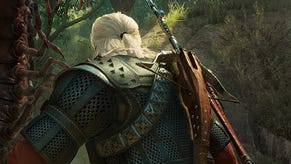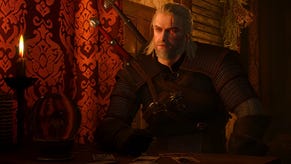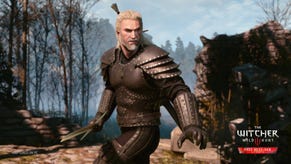The best Resident Evil games ranked from worst to best
In this ranking of the best Resident Evil games, we decide which ones are Tyrant-grade and which ones are basic, brain-dead zombies.
What is the best Resident Evil game of all time? A question often posed, that more often ends in arguments between keen Resident Evil veterans.
A beloved series from Capcom, Resident Evil’s core titles vary wildly, with its spin-offs branching off from the beaten path even further. There’s plenty for any Resident Evil fan or newcomer to pick from, but which games are your time best spent with?
With the release of Resident Evil 4 Remake being the latest title in the series to grace us, now is a better time than ever to lay this discussion to rest. Here are all of the Resident Evil titles, ranked from worst to best.
Disclaimer: This article is a merge of two previous lists; one that appeared on USGamer, a partner publication of VG247, and one written by Andi Hamilton. The lists have been merged, editorialised, and added to by VG247 staff to provide the most comprehensive and up-to-date ranking of the Resident Evil series possible. Enjoy!
The best Resident Evil games ranked from worst to best
- 23. Resident Evil Survivor, Survivor 2, and Dead Aim
- 22. Resident Evil Gaiden
- 21. Umbrella Corps
- 20. Resident Evil: Operation Raccoon City
- 19. Resident Evil Outbreak and Outbreak File #2
- 18. Resident Evil: The Mercenaries 3D
- 17. Resident Evil: The Darkside Chronicles
- 16. Resident Evil: Revelations
- 15. Resident Evil 6
- 14. Resident Evil
- 13. Resident Evil 0
- 12. Resident Evil 5
- 11. Resident Evil 3 (Remake)
- 10. Resident Evil 3: Nemesis
- 9. Resident Evil: Code Veronica
- 8. Resident Evil: Revelations 2
- 7. Resident Evil 2
- 6. Resident Evil (Remake)
- 5. Resident Evil 8: Village
- 4. Resident Evil 7: Biohazard
- 3. Resident Evil 4
- 2. Resident Evil 4 (Remake)
- 1. Resident Evil 2 (Remake)
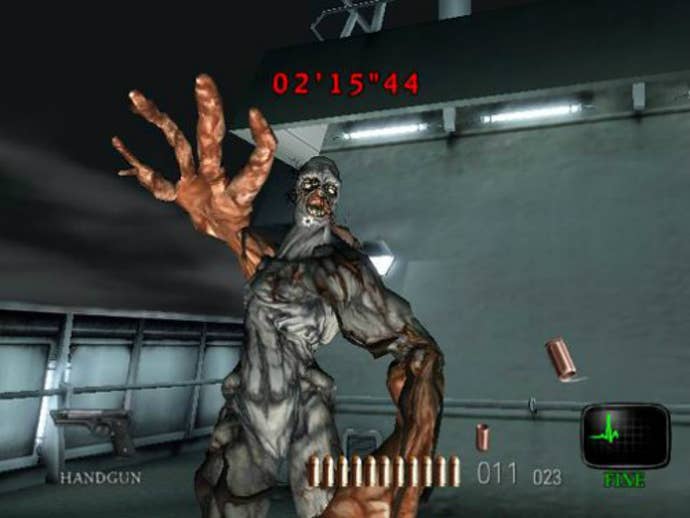
23. Resident Evil Survivor, Survivor 2, and Dead Aim
Here at the end of our list, we package up a whole series of games as a single entry. It's actually three different games: 2000's Resident Evil Survivor, 2001's Resident Evil Survivor - Code Veronica, and 2003's Resident Evil: Dead Aim. (Four games if you count Dino Stalker, based on the same engine, but using the Dino Crisis series for inspiration.) All three games were made to support Namco's GunCon and GunCon 2 light gun peripherals for PlayStation and PlayStation 2.
The problems started early and mounted up. The first game came out after the Columbine High School shooting, so light gun support was removed. The second game, for PlayStation 2, was originally developed for arcades by Namco, and ultimately didn't make it over to the United States. Dead Aim was developed by Cavia, the folks behind Dragon Ball Z: Supersonic Warriors, Drakengard 2, and the awful Beat Down: Fists of Vengeance. It had light gun and mouse support, and tried to stick closer to the original series by having a third-person viewpoint when moving and a meatier story to it.
Dead Aim is the best of the bunch, but it's not a great Resident Evil game, nor is it a particularly exciting light gun game. It was a failure in both directions, for a spinoff series that was generally a failure all around. — Mike Williams
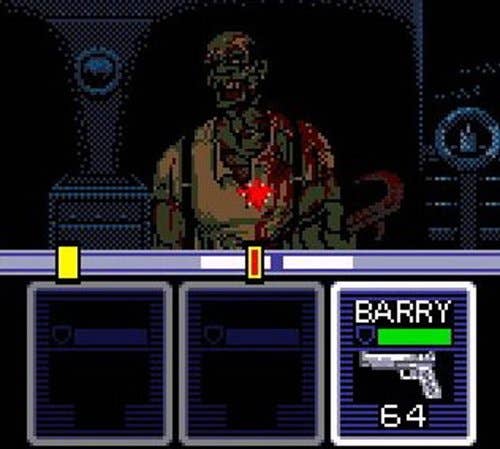
22. Resident Evil Gaiden
There was a time when publishers were desperately trying to fit their big-budget games onto the Game Boy and Game Boy Color. Many of these games only tangentially had anything to do with their PlayStation, PlayStation 2, Xbox, and GameCube counterparts. Resident Evil Gaiden is a cast-off of that era.
Resident Evil Gaiden has RE 2's Leon Kennedy and RE's Barry Burton exploring a luxury cruise ship where an outbreak has taken place. (If you're up on your Resident Evil, that's also the setting of the portable Resident Evil: Revelations.) Gaiden offers exploration from a top-down viewpoint, with your character wandering the decks of the ship. If you ran into a monster, the game would switch to first-person RPG combat. In these instances, there's a bar with a reticle sliding back and forth, determining your hit range. Players had to time button presses to damage an enemy, or outright kill them; it's an ugly system overall and did Gaiden no favors.
Out of the entire sprawl of Resident Evil games, this is one of the few considered non-canon. Just leave it behind. — Mike Williams
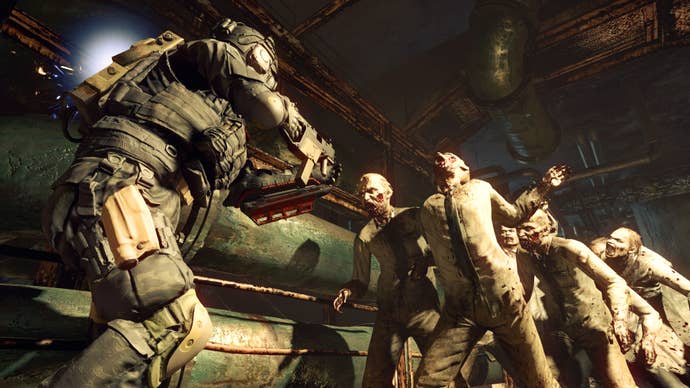
21. Umbrella Corps
If your only experience with Resident Evil was Umbrella Corps, you would be utterly baffled by every new game that came after it. This series is built on tension, carefully crafted clockwork levels, puzzles that involve clock hands, and undead that, at their best, provide a meaningful encounter. Umbrella Corps is none of those things.
Umbrella Corps is the maw into which Capcom dumped all the buzzwords that couldn’t fit in a proper Resident Evil. Umbrella Corps is an arcade survival-shooter where soldiers slide around the floor at inhuman speeds, while zombies shamble about like decorative ducks in an old-timey shooting gallery.
Umbrella Corps is the made-up game for an episode of Law & Order about gamer crimes, only sold in real life at your local stores. A half-hearted attempt to make a multiplayer Resident Evil-lite, cash in on a few gameplay trends that were hot three years prior to its release, and move along to something infinitely more worthwhile. — Eric Van Allen

20. Resident Evil: Operation Raccoon City
In 2012, Capcom once again tried something different with the Resident Evil franchise. Developed by Slant Six Games, the now-defunct studio behind SOCOM U.S. Navy SEALs series, Resident Evil: Operation Raccoon City had a clear vision at least. The idea was to marry SOCOM play to Resident Evil, putting players in the shoes of an elite military force trapped in Raccoon City.
The final result wasn't all that great, though. Operation Raccoon City had a single-player mode, but it's little more than window dressing for a series of unconnected missions. The real meat was online play, pitting two squads of six players against one another and the zombie hordes. But sadly, the gunplay was underwhelming and even at its best, Operation Raccoon City is simply boring. There's life in the idea, but this isn't the beating heart of it. — Mike Williams
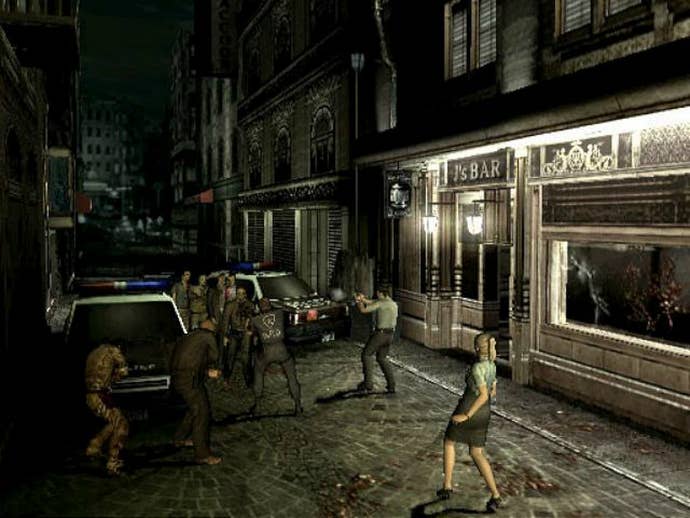
19. Resident Evil Outbreak and Outbreak File #2
The story here is quite similar to Operation Raccoon City, and the conception of that game probably had its genesis in Outbreak. Both Outbreak titles are cooperative online Resident Evil experiences, taking place at the same general time as Resident Evil 2 and Resident Evil 3: Nemesis. The aim was to make an online Resident Evil, for use with the PlayStation 2 Network Adapter.
Outbreak and its sequel aren't entirely unsuccessful attempts at online RE, especially since they released on the PlayStation 2 back in 2003-2004. As you jump from character to character across the episodic storyline, you get snippets and highlights of the common man's story during the Raccoon City outbreak. Players had to work together to defeat the zombie hordes and complete objectives. Unfortunately, the scenarios available were pretty short, the monsters are mostly reused, and the story isn't that great. Also, since it was online, players had to contend with being unable to pause to check their inventory for the first time in series history. Folks hated that. — Mike Williams
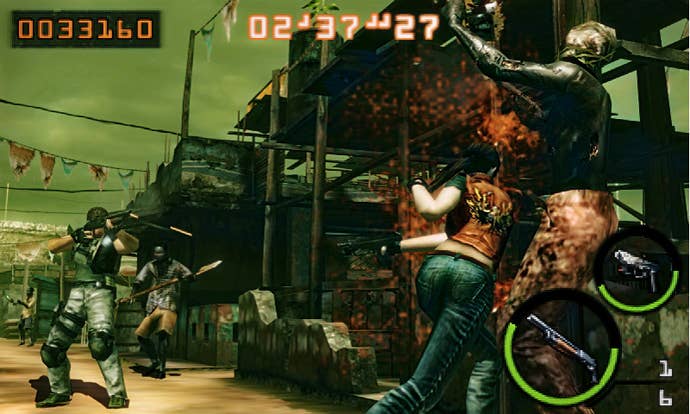
18. Resident Evil: The Mercenaries 3D
Based on the popular time attack mini-game in Resident Evil 4, Resident Evil: The Mercenaries 3D does a good enough job of making a case for Nintendo's somewhat gimmicky handheld. The arcade-y gameplay of Mercenaries, where players take control of a popular Resident Evil character and try to kill as many zombies as they can in the allotted time, even works well on the go.
In fact, the decision to spin Mercenaries off as a separate games makes sense, and Capcom has since expanded the arcade-y side modes into longer games like Operation Raccoon City. While Mercenaries 3D played fine and looked fine, the lack of content makes The Mercenaries 3D more of a power demo for the 3DS than a must-play Resident Evil game. — Matt Kim

17. Resident Evil: The Darkside Chronicles
While every Resident Evil fan in 2009 was eagerly anticipating the release of Resident Evil 5, Wii fans were left with the light gun shooter, The Darkside Chronicles, as a consolation prize.
A sequel to the Umbrella Chronicles light gun shooter (Capcom has made a surprising number of these for the Resident Evil franchise), the Darkside Chronicles had one advantage over early RE light gun games: motion controls. Thanks to the Wiimote, playing Darkside Chronicles felt like a true arcade experience rather than a cheap thrill ride. The only problem is that ultimately there's no way an arcade experience competes with the full Resident Evil experience. The updated visuals for classic Resident Evil games and original side story starring Leon Kennedy were a nice touch, however. — Matt Kim
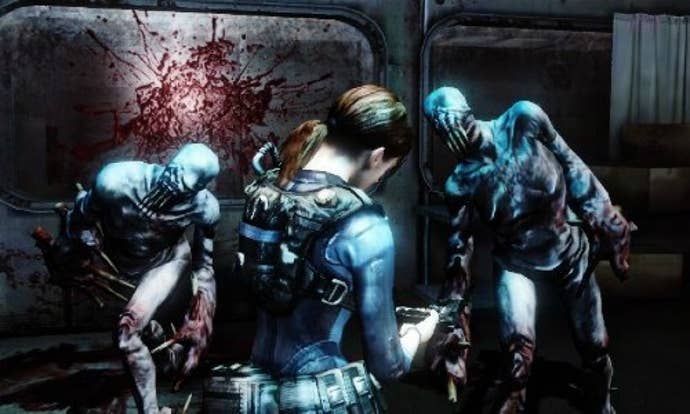
16. Resident Evil: Revelations
No one thought a Resident Evil game on Nintendo 3DS could work. And with Resident Evil: Revelations, well, they were mostly proven wrong. It may not hold up to today's standards, especially after the HD update of it placed it on more capable hardware, but it was still an impressive game for how far it pushed the 3DS.
Resident Evil: Revelations may be the most claustrophobic feeling game of the series, and it's that way by design. The corridors are narrow, and barely edge you in movement. (You are, dominantly, on a creepy ship, after all.) While you can move and shoot at the same time—unlike most other games in the series—you're still fairly restricted. (Unless you have that pesky Circle Pad Pro attachment for your 3DS, which helps enable camera movement.) The first Revelations is an impressive outing for Resident Evil on such a portable console, and even if it doesn't stand shoulder to shoulder with the best in the series, it will be remembered for doing the unexpected and bringing Resident Evil to portable in a big way. — Caty McCarthy
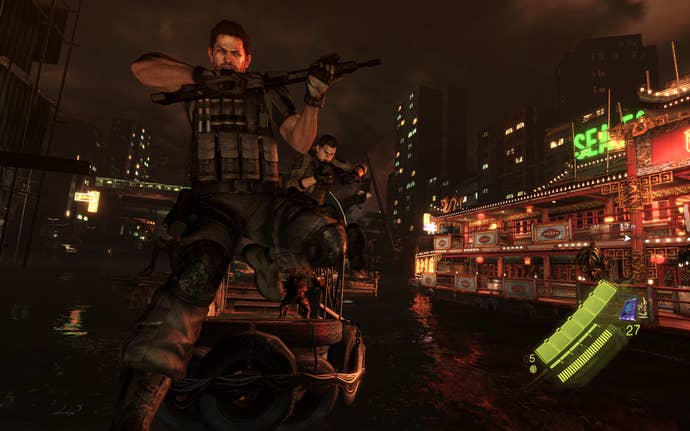
15. Resident Evil 6
An absolute mess of a game. Three separate campaigns and barely a single good idea between them, it’s bloated, far too long, and far too focused on action. Resident Evil 6 is not a survival horror game - it’s a game suffering from a serious identity crisis, resulting in this mismatch of styles.
First, the good - what little of it there is. Leon Kennedy’s campaign is alright: a nighttime jaunt through a city full of the undead, this comes the closest to capturing the essence of survival horror and the pacing of Resident Evil 4.
Human bicep Chris Redfield and Jake Muller, son of series antagonist Albert Wesker, have much more action-focused campaigns, however. Chris regularly finds himself tucked up behind cover like Marcus Fenix, while Jake runs around battering folk. Leon’s German Suplex in Resident Evil 4 was an occasional delight, busted out on a wounded enemy for a spectacular kill, but Jake can pull off this sort of thing with reckless abandon. The tension is gone and I’m blaming the movies.
The thing is, while it might not be survival horror, this isn’t exactly a stellar action game, either. The controls, especially in the more action-led campaigns, are rough as hell, seemingly trapped between wanting to be a shooter, but also wanting to retain the stop/start combat of the previous two games. It doesn’t commit to either, and what they’ve ended up with doesn’t feel good at all.
Resident Evil 6 is proof that bigger doesn’t mean better. — Andi Hamilton
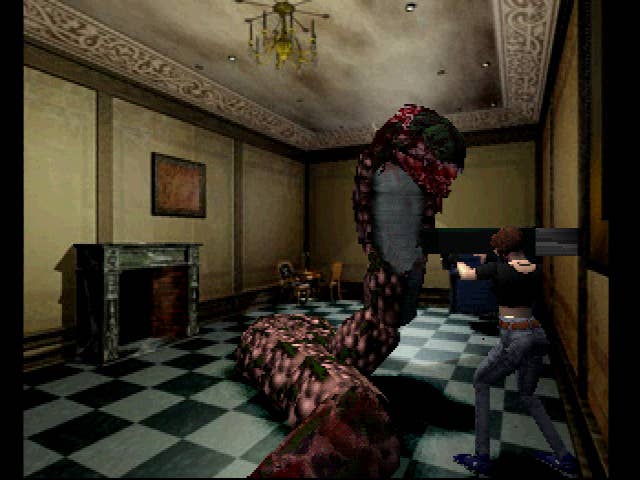
14. Resident Evil
The granddaddy of the entire franchise rests here on our list. Originally conceived as a remake of another Capcom horror game for the Famicom, director Shinji Mikami would end up finding inspiration in The Shining, Alone in the Dark, and more, becoming the Resident Evil we know and love.
This is the official beginning of the Umbrella Corporation, S.T.A.R.S., Chris Redfield, Jill Valentine, Albert Wesker, and the whole rest of Resident Evil's meandering storyline. It's you in a vast mansion, with zombies and other mutated monsters, trying to solve puzzles with increasingly odd keys and ultimately survive the night.
The fixed camera, the limited inventory, the sparse ammo, and the weird tank controls; there was nothing else like Resident Evil at the time. The thing is, the original Resident Evil didn't age all that well. If you're looking to revisit it, you're better off with the 2002 remake, though that does mean you lose some of the B-movie charm from the voice acting and live-action opening. — Mike Williams

13. Resident Evil 0
Resident Evil 0 is at its best at the start of the game, when S.T.A.R.S. medic Rebecca Chambers wakes up on a spooky train. It's a novel setting for a horror game, one that distils the claustrophobic dread of early Resident Evil games into a literal location. Alas, Resident Evil 0 stops being a unique entry into the franchise the moment it enters its more conventional mansion location.
And while Resident Evil 0 absolutely still appeals to fans of Resident Evil Remake, the game wasted an absolutely stellar setting when Rebecca and Billy leave the Ecliptic Express. Years later, I'm almost mad that Resident Evil 0 ditches the train early on to become just another spooky mansion game. At least Train to Busan had the courage to leave one train for another. — Matt Kim

12. Resident Evil 5
So, a bit of history. Resident Evil 4 not only redefined the Resident Evil series, it also redefined the action game genre. In the years following, the third-person, over-the-shoulder shooter was commonplace, with Gears of War leading the charge. Enter Resident Evil 5, a game that takes inspiration from the genre its predecessor inspired and, in doing so, ended up being pretty uninspiring itself.
A full co-op campaign was a new introduction, puzzles were reduced, and occasional horde battles took their place. In an attempt to appeal to this new, massive audience who wanted more Gears of War, Resident Evil began to lose sight of what made it so special, a mere one game removed from its great reinvention.
Still, Resident Evil 5 can be a fun co-op action game. Played on your own, there are plenty of frustrating sections where you’re split from your AI partner and are left waiting on them. But with a pal, these moments are frantic scrambles as you try to figure out how to get back to one another. It was so clearly designed with two players in mind, it almost seems daft to play it in any other way. — Andi Hamilton
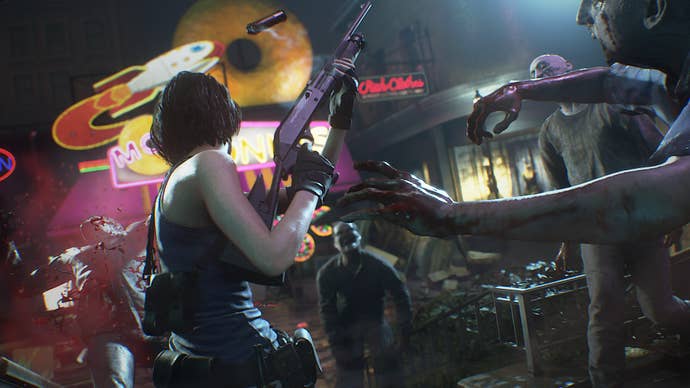
11. Resident Evil 3 (Remake)
Given a second chance at tackling the wobbling bridge between Resident Evil’s horror roots and the explosive action of future entries into the series, Capcom went ahead and gave the world the Resident Evil 3 Remake. A damn good attempt at modernizing Jill’s own nightmarish evening in Racoon City and giving Nemesis, arguably the best villain in the series, a fantastic makeover.
Tragically, history somewhat repeated itself for the Resident Evil 3 remake. Coming out shortly after the Resident Evil 2 remake, it didn’t quite shock the world as much as either its predecessor or the RE4 remake. While Nemesis is brilliant, he is far and away less threatening than before. Cut areas like the Clock Tower, the press office, the park and more leave a sour taste for RE3 fans. If only this game got more time the second time around.
It’s not all bad though, with brilliant touches here and there (shout out to the link between the parasite in Nemesis and RE4 that helps tie the series together nicely) the RE3 remake just doesn’t quite live up to an already imperfect original. Speaking of which… - Connor Makar
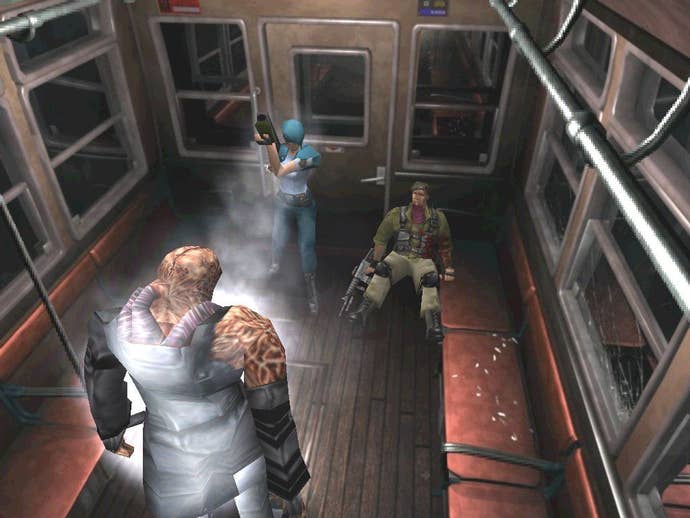
10. Resident Evil 3: Nemesis
At times feeling like an expansion pack for Resident Evil 2, this title put you back in control of Jill Valentine and had you cutting about Raccoon City with more of a lean towards action. There are many more zombies, a lot more ammo, and blasting your way through areas instead of running is much more necessary.
Heading into the Raccoon City Police Department from Resi 2 is a cool moment, full of nice nods and winks to what took place in that game. A much more open Raccoon City also brings a slightly different pace to the tried and tested formula.
It did, however, have an ace in the hole - the Nemesis. Expanding on what Capcom started with the Mr. X character in the B Scenario of Resident Evil 2, The Nemesis is a near-unkillable bioweapon that stalks you throughout the game like the bloody Terminator. The first time he travels between areas - something no enemy had done up to this point - was a genuinely terrifying moment.
There’s also the unlockable Mercenaries mode. Very different to the Mercenaries that graces later games in the series, Mercenaries takes a section of the game and allows you to play through it score attack style with a bunch of different characters, featuring different weapons and approaches. It is damn fun.
Resident Evil 3 is the weakest of the three PS1 titles, but like the first three Die Hard films, the weakest is still a damn good way to spend your time. - Andi Hamilton

9. Resident Evil: Code Veronica
Code Veronica stands out for probably having the strongest narrative of the pre-Resident Evil 4 Capcom zombie games. Code Veronica told a story that was as much Thomas Harris as it was Resident Evil. And headlining this entry were the two Redfield siblings, Chris and Claire.
The psycho-thriller plot of the Ashford twins on Rockfort island made for a compelling hook, and was probably the closest the series got to some of the psychological trappings of cerebrally driven horror game contemporaries like Silent Hill. Although I'd stop short of calling Code Veronica a full psychological horror game.
By pitting sibling against sibling, Resident Evil's rah rah action hero stereotypes gained some extra dimension. And taking the action outside of Raccoon City grew opened up the lore of Resident Evil. We probably could've done without Steve Burnside though. — Matt Kim

8. Resident Evil: Revelations 2
Most people have not played this game. Revelations 2 was released episodically back in 2015 to very little fanfare. It was an experiment by Capcom, making a Resident Evil without the budget or visual bells-and-whistles that categorize many of the mainline entries. It was quickly forgotten, a mere footnote in Resident Evil history.
Revelations 2 is a damned good Resident Evil game, though. The first Revelations suffered from trying to fit everything RE into the 3DS, but Revelations 2 is surprisingly focused. Across the four episodes, you play as either Claire Redfield or Barry Burton. It takes place in two time periods. Claire and Barry's daughter Moira is in the past, having been kidnapped and stranded on Sushestvovanie Island under the watch of the mysterious Overseer. Barry's adventure is six months later, as he comes to the island to find Claire and his daughter, only to be met with a strange girl named Natalia. Both halves build on one another over the course of the episodes.
Everyone praised Resident Evil 2 for its direct return to the old school RE formula, but Revelations 2 did it first. The island is full of interesting unique environments, including the prison, a mansion, a huge lab, and even the open forest, as opposed to the cramped corridors of the boat in Revelations.
Enemy variety is stronger here, instead of the mostly-human Ganados and Majini of RE 4 and RE 5. The focus is on classic survival horror, unlike the wildly different gameplay types of Resident Evil 6. Light and darkness plays heavily into Revelations 2, with many regions offering only your flashlight or a flickering lamp as a source of safety. It does all this while maintaining the goofy tone of the franchise, offering very bad dialogue with a completely straight and sombre tone.
Its biggest misstep is probably the ending, but up until that point, it's pure Resident Evil with no fluff or nonsense. It's focused, but there's some ambition here, and the writing is generally better than some of the entries further down this list. And you can burn through the whole campaign in 8-10 hours, so it's not a huge drain on your time. — Mike Williams

7. Resident Evil 2
While it's since been outstripped by its excellent remake, the original Resident Evil 2 holds up pretty well. After the success of the first Resident Evil, Capcom wanted to build something bigger and better. Resident Evil director Shinji Mikami switched over to producing, and he turned to young upstart designer Hideki Kamiya for the second entry. Kamiya moved the setting to the streets of Raccoon City, with multiple lead characters fighting hordes of zombies. A lot of that original experience—Resident Evil 2 was completely overhauled mid-production—made its way into the final product.
Resident Evil 2 introduced the world to Leon Kennedy and Claire Redfield, the former of whom would take the sole starring role in Resident Evil 2. Each had their own scenario, and through the "Zapping System," the actions in one scenario would affect the second playthrough with the other character. It was bigger than its predecessor, moving beyond the confines of a single mansion to deliver players to a city under a massive viral outbreak.
At the time of its release, Resident Evil 2 was damn near a playable Hollywood film. Yes, the polygonal characters haven't aged that well, but in the PlayStation era it looked like a stunner, with those lavish rendered 3D backgrounds. And with the addition of Kamen Rider and Super Sentai writer Noboru Sugimura to the team, the story of Resident Evil was leaps and bounds ahead of the first game. All RE 2 had to do was be bigger and better than the original, something it did with seeming ease. — Mike Williams
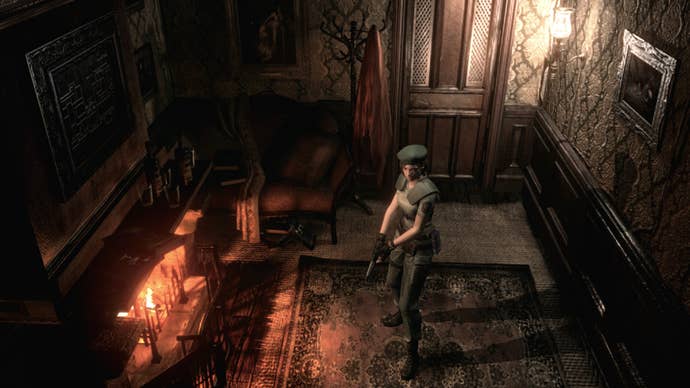
6. Resident Evil (Remake)
One of my earliest memories is waking up late at night, stumbling into the living room because I heard my mom and the television on, only to find a scary zombie turning toward the screen having just sucked down some brains. Little did I know back then, it was the early moments of Resident Evil, and my mom was playing it while little ol' me was in bed. Then I cried, and she felt really bad that I saw such a scary thing.
The Resident Evil Remake, which I feel like I've started over and over again on virtually every platform on this point, is always solid. It feels old school still, in a way the most recent Resident Evil 2 remake does not. The graphics may not be amazing in 2019, but the rough edges of the original PlayStation entry are gone. The story is carefully tuned for HD, with a revised script trickling in the mystery of whatever's behind the T-Virus outbreak, before the Umbrella-saturated plot goes in a variety of directions in its successors. Even in 2019, it's proof that sometimes you just can't beat the simplicity of the first Resident Evil, where it's largely just Jill or Chris, a creepy mansion, a mystery, and zombies in your way. — Caty McCarthy
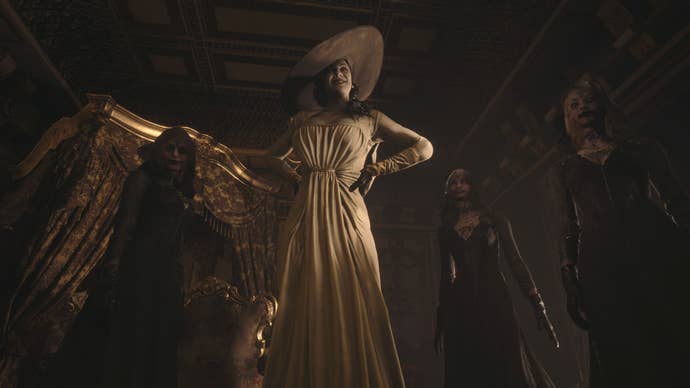
5. Resident Evil 8: Village
After Resident Evil 7: Biohazard brought the Resi series back to a truly terrifying place, I was scared as to what Resident Evil 8: Village would entail. To my relief, it pivoted away from the sheer horror of Biohazard. Though, it still remains scary while also treating us to a semi open-world reminiscent of Resident Evil 4.
Rather than tackling the undead, we face a very different type of threat in Village, namely in the form of vampires, werewolves, and even a huge robot. Ultimately, it all ties in to what happened in that Spanish village however many years ago, and I spent much of my time as Ethan Winterw wondering exactly what Leon Kennedy must be up to right now.
While it was nice to see Capcom try something different, and create a game that clearly paid ode to the series’ best, I can’t help but feel the tiniest bit disappointed with Village’s pacing at the best of times. Made up of multiple fascinating environments, Village actually peaks in the first third as we explore the castle, fleeing the omnipresent threat of vampire ladies. After this, despite the enthralling boss fights that follow, pacing begins to feel off, and no later environment quite compares to the illustrious Castle Dimitrescu.
That said, Village’s DLC, Shadows of Rose, was no less than amazing. Inviting us back into House Beneviento once more, the expansion has us play as Rose Winters for a change, and is one of the scariest Resident Evil experiences to date. Warning: If you hate dolls, you’ll hate this. - Kelsey Raynor
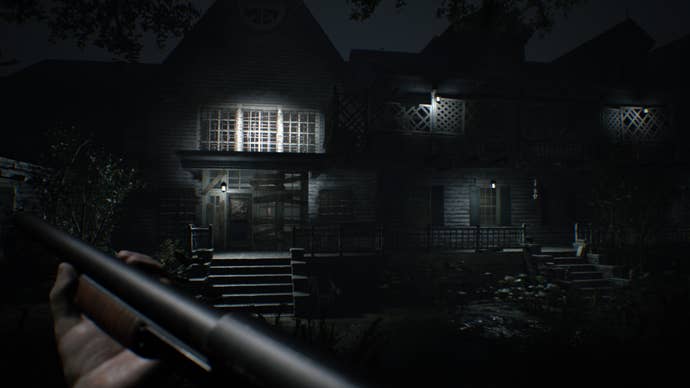
4. Resident Evil 7: Biohazard
After the bombastic Resident Evil 6 burned all the heat out of the action side of the franchise, Capcom needed to do something drastically different. It didn't want to entirely go back to the original style that categorized all the games up until Code Veronica, but it did want to return to the horror and tension of not knowing what was around the next corner.
Enter Resident Evil 7: Biohazard, whose title was is a reference to the Western and Japanese titles of Capcom's horror series. (The Japanese title is Biohazard 7: Resident Evil.) Instead of focusing on Chris, Jill, Leon, Claire, or any familiar characters, Resident Evil 7 is about Ethan Winters, a man who is lost in the despair of losing his wife. When he receives a message from his dead partner, telling him to come to a Louisiana farmhouse, he does. This very bad decision lands him in the clutches of the crazed and mutated Baker clan.
The biggest change in Resident Evil 7 is the switch to a first-person viewpoint. But when you step back from that, the rest of the game is remarkably similar to previous Resident Evils. Ethan is alone in the house, with a few weapons, the ability to craft healing items, and a host of odd puzzles to solve. While the camera recalls modern horror games like Outlast, Amnesia, and P.T., Resident Evil 7 showed that Capcom didn't forget what made the originals so exciting. The horror of running from one of the Bakers, or faceless Molded, is enhanced because you're directly put into Ethan's viewpoint. And the Bakers themselves are probably some of the most memorable villains of the franchise, at least within the confines of a single game. (Wesker needed time to ramp up.)
Not only that, but Resident Evil 7 is probably one of the best VR games around. You can play the entire game from start to finish in VR, and it's a fantastic experience. That's only enabled because of the shift to first-person. There's nothing like seeing Ethan's supposedly dead wife Mia coming directly at you out of the darkness in VR. I almost freaked out and threw off the PlayStation VR headset multiple times.
If Resident Evil 7 is the third era of the franchise, it's off to an amazing start. And I hope Capcom sticks with it, given that the remake games can only carry the torch of the first era. — Mike Williams
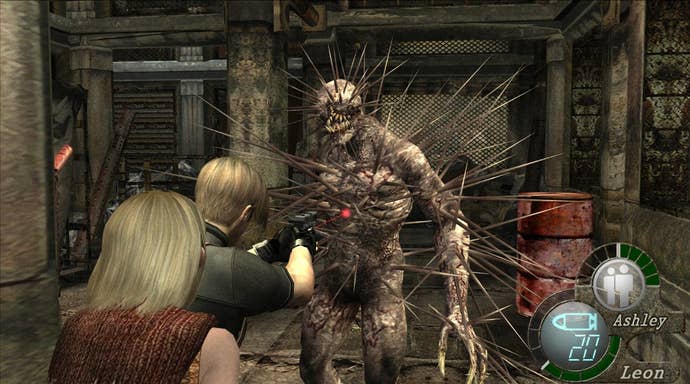
3. Resident Evil 4
Everyone goes back to the village when talking about Resident Evil 4. It's one of the most unnerving scenes in gaming history; a terrifying chase sequence backed by the rusty growl of a chainsaw. I could write a whole article about how perfect these opening moments are, and how they so expertly establish Resident Evil 4's premise and stakes. The townsfolk aren't zombies, sure, but there's something even more terrifying about the dead-eyed way they shuffle toward you with torches, pitchforks, and power tools. It confronts you with an immediate mystery: What the hell happened to these people?
Diehard fans like to complain about Resident Evil 4's emphasis on action over horror, but that opening sequence alone makes Resident Evil 4 as creepy as anything in the entire series. And there are plenty of genuinely freaky moments that follow, including the first time you discover that headshots aren't always the best method for dealing with Resident Evil 4's myriad foes. Remember the Regenerator? I still shudder when I envision that weirdly featureless and alien horror shuffling toward me, its torso packed with Plaga. As someone who's more than a little squeamish about body horror, I'm honestly amazed I made it all the way through Resident Evil 4 without tapping out.
But I guess it was just that good, ultimately. We tend to forget in light of Resident Evil 4's clunky third-person controls and dated graphics, but it was amazing when it arrived on GameCube in 2005. It was one of the best-looking games of its generation, and a massive step up from virtually every other action game of the era. It portended the explosion in popularity of third-person action games in the generation to follow, particularly Naughty Dog's Uncharted series; and it revived the flagging fortunes of the Resident Evil series at large, which had begun to seem dated with its fixed camera and archaic tank controls.
Fifteen years later, Resident Evil 4 remains as popular and influential as ever—the standard by which every new entry is judged. Who needs zombies anyway? — Kat Bailey
.jpg?width=690&quality=70&format=jpg&auto=webp)
Resident Evil 4 (Remake)
As far as mainline Resident Evil games go, Resident Evil 4 has always reigned as the most popular of them all. It’s not necessarily the best game in the series, with your personal favourite no doubt depending on your affinity towards action and Ganados, but there’s no denying Leon Kennedy’s adventure in a parasite-ridden Spanish village left a mark on all those who played it.
The long-awaited Resident Evil 4 Remake simply strengthens the game's most pivotal moments. Some of the comical, camp flavour that many of us knew and loved has been lost to time, but we’re left with a much more mature version of RE 4, and for the better. Gunplay feels more satisfying, enemies are all-the-more fascinating to look at, and RE 4’s story and characters truly have their time to shine. At long last, Ashley Graham is also no longer a burden to be around, and we even get to spend more time with the wonderful Luis Sera; I couldn’t ask for much more.
It’s scarier than the original, with evolved puzzles, improved pacing, and plenty of Easter eggs for long-time fans. Simply put, Capcom delivered (almost) everything fans wanted with the RE 4 remake while retaining the game's charm, and it stands tall as one of the best Resident Evil games out there. - Kelsey Raynor
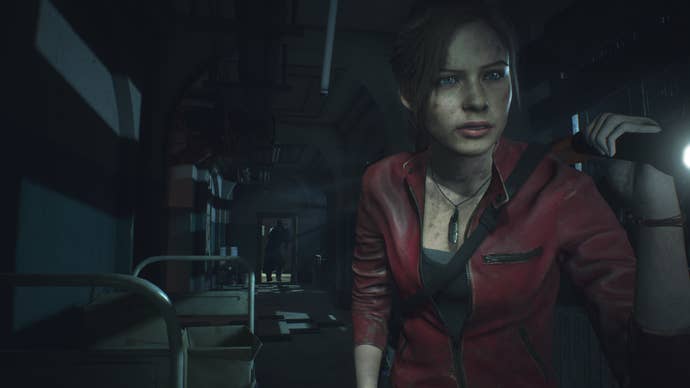
1. Resident Evil 2 (Remake)
There's an idea that a game needs time before it can be truly appreciated. But Resident Evil 2 arrived with such conviction and sense of self that time will only make Resident Evil 2's triumphs more apparent. Every Resident Evil game before it, including Resident Evil 4, had some kind of growing pains. In an effort to modernize the way Resident Evil plays, feels, or looks, something else ends up failing to click all the way. Every Resident Evil game up until Resident Evil 2 had some kind of caveat.
Resident Evil 2 feels effortless from beginning to end. Resident Evil 2 finds that elusive sweet spot between horror and action better than any game in the series before it. Not only that, but the liberties Capcom took with the Resident Evil 2 remake demonstrates a confidence in vision that other Resident Evil games lacked.
The gunplay, already perfected by Resident Evil 4's over-the-shoulder style shooting, makes a welcome return. But the real treat is how Leon and Claire interact with the environment. Despite the difference in perspective, the tactile nature of the world could only be possible after Capcom's excursions into first-person and VR with Resident Evil 7.
Rather than give Resident Evil 2 a simple facelift, Capcom seemed driven to capture a vision of Resident Evil games as they were always meant to look and feel. Playing the remake, you get a feeling that the powder blue hue of the night, the oppressive wetness of the rain was always supposed to be there. The only reason they weren't there in the original was because of a lack of technology. But that technology is here now, and combined with all the right lessons learned from the original Resident Evil remake, 4, and 7, Capcom showed the world what a true Resident Evil game is supposed to be. — Matt Kim





